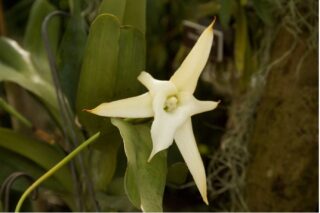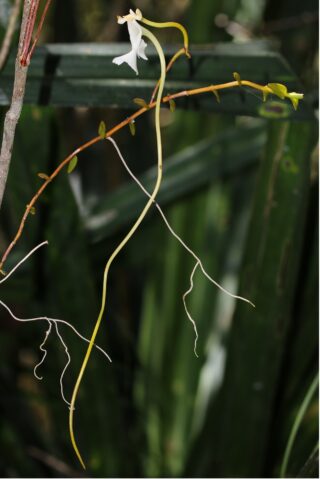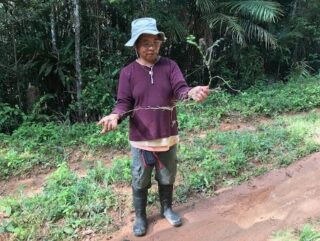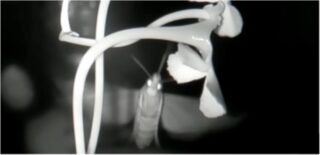International team of Scientists Describe New Orchid Species Related to Famous Darwin’s Orchid
Urgent conservation actions for the novel species are needed, scientists say.
The island of Madagascar is a unique laboratory of evolution and biodiversity with an estimated 85 percent of its fauna and flora being endemic (i.e. only found there). Chameleons, lemurs and orchids are only a few of Madagascar’s iconic group of species present in this biodiversity hotspot. As such, it is also a dream for naturalists.

Darwin’s Orchid, Angraecum sesquipedale. Photo by Simon Verlynde.
One of the most well-known Malagasy orchids is Angraecum sesquipedale, known as Darwin’s orchid. The name pays tribute to Charles Darwin’s theory that the flower was pollinated on a not-yet-discovered moth with a long proboscis. Scientists described the large hawkmoth Xanthopan praedicta, 41 years after his prediction. This story of a unique plant and pollinator is one of the most celebrated predictions of the theory of evolution.
There are more “Darwin orchids” hidden in the remaining forests of Madagascar. A newly published paper, “A new orchid species expands Darwin’s predicted pollination guild in Madagascar,” reveals an unexpected new case of parallel evolution with Darwin’s orchid in the newly described giant-spurred Solenangis impraedicta whose nectar tube reaches a whopping 33 cm in length.
“The contrast between the little 2-cm flowers and the hyper-long nectar tube is mind-blowing” said coauthor João Farminhão of the Coimbra University Botanic Garden.

Solenangis impraedicta in the wild. Photo by Marie Savignac.
Solenangis impraedicta has the third longest spur ever recorded amongst flowering plants, and the longest nectar spur of any known plant relative to flower size. It is the only new orchid species with such an extreme adaptation to hawkmoth pollination described since 1965.
Patrice Antilahimena, a Missouri Botanical Garden (MBG) field botanist, first collected the species in 2009, during the baseline environmental impact study of a mine site in Central-Eastern Madagascar. Several botanists scratched their heads to identify these samples, and finally, with the help of a closely related species of East Africa, agreed on it being a new species Solenangis, making it the first of the genus in Madagascar!
Ten years later, Brigitte Ramandimbisoa, MBG’s orchid specialist in Madagascar and Simon Verlynde, Ph.D. student at The New York Botanical Garden, stumbled upon the species again in a new location. “After trying to find this species again without success for several field trips, it took us a few seconds of starring at each other in disbelief as we realized what we had found, this time without even looking for it” said Simon Verlynde.
Mining activity and potential poaching for the orchid trade threaten this sensational new member of “Darwin’s pollination guild.

Brigitte Ramandimbisoa holds Solenangis impraedicta. Photo by Simon Verlynde.
“A precautionary approach is required when publishing such a spectacular new species. Wild populations must be protected and monitored and detailed information on their precise coordinates must be kept out of the public domain. So, don’t ask us to reveal where we found it, somewhere in Madagascar,” added Tariq Stévart, an expert in African orchid taxonomy. The novelty belongs to the angraecoid orchids group that Stévart and an international team of experts have extensively studied.
The 15-year gap between this species’ discovery and formal description allowed the team to implement conservation measures before the giant-spurred Solenangis achieves stardom. These include ex situ cultivation (the process of protecting a species outside of its natural habitat) and seed banking as part of a collaboration between MBG and the Ambatovy Conservation Department.

A still image from the camera trap Marie Saviganc setup to find Solenangis impraedicta‘s pollinator.
The pollination biology of Solenangis impraedicta was preliminarily studied using camera traps by Marie Savignac in 2019. The observational period did not result in any conclusive pollination events. However, the most likely pollinators are the large hawkmoths, Coelonia solani and Xanthopan praedicta. The species name impraedicta, meaning unpredicted in Latin, is a nod to Darwin’s prediction of the star orchid pollinator, which took 130 years to confirm in full. Hopefully, this time it won’t take as long to identify the pollinator in the act.
SUBSCRIBE
Enter your email address to subscribe to this blog and receive updates on new posts.











